Israeli high-tech is undergoing a transformation – its employees are not as young but are still based in Tel Aviv. One tenth of employees in Israel work in high-tech and pay a quarter of the country’s total income tax. One in every four students is studying a technology subject and will soon attempt to integrate into the high-tech industry, however the Covid crisis has made the industry tougher for women and inexperienced juniors. Will they find work after completing their studies?
The Effect of the Covid Crisis on the High-Tech Human Resource
In a year during which the Israeli economy suffered from high levels of unemployment, its hightech sector also sustained setbacks and job losses, although these were moderate compared to the rest of the economy and were primarily sustained by low salary employees. Despite the job losses, the total number of salaried employees in the high-tech industry increased during the year by 4%, compared to an increase of 7%-8% during the each of the two years prior to the crisis. The high rate of unemployment throughout all sectors of the economy due to the Covid crisis that led to reduced participation in the workforce, resulted in an increase in the relative share of high-tech employees out of the total number of employees. In 2020, the number of hightech employees stood at 334,619, comprising 9.8% of all salaried employees. In total, the ratio of high-tech employees has grown from 7.6% to 10% over the last decade.
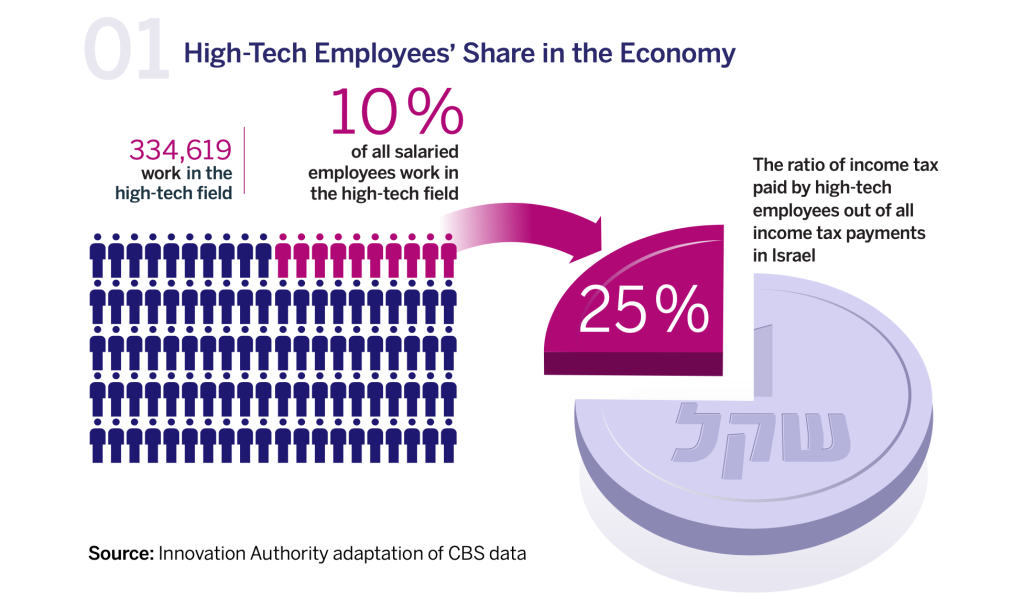
Regarding the internal makeup of high-tech employees, this year saw the continued increase in the ratio of employees in high-tech’s service sectors, software, and research and development. This occurred parallel to a decline in the ratio of employees in the industrial sectors working in pharmaceutical and electro-optics manufacture etc. In fact, since the beginning of 2011, the ratio of employees in these service sectors has been higher than those working in industrial sectors and this gap has continued to expand.
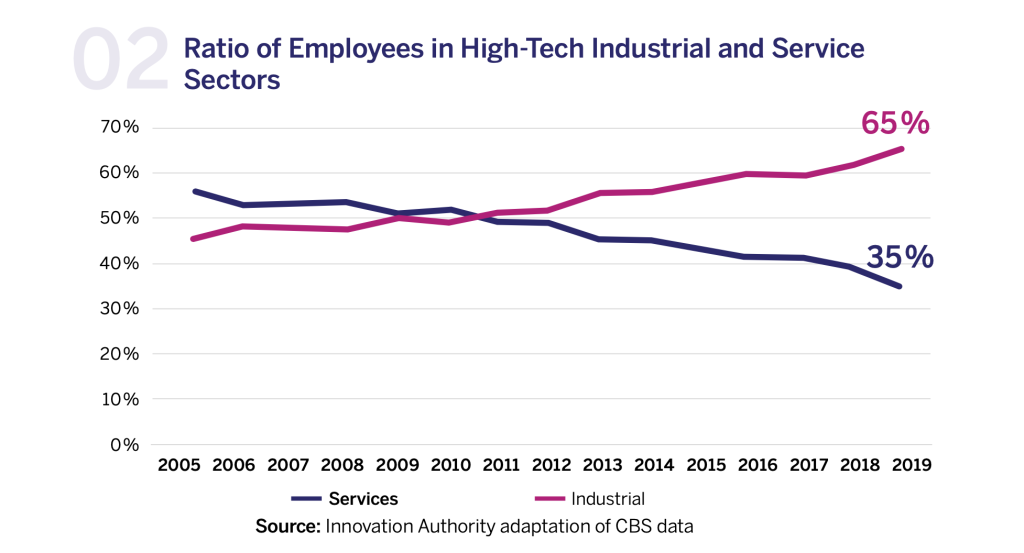
This trend has significance for the variety of high-tech employment. An examination of the characteristics of employees in the different companies reveals that high-tech industrial sectors employ relatively more employees with training that is not necessarily technological such as marketing, finance, human resources etc. for every core technology employee compared to the high-tech service sectors. In other words, high-tech industrial companies are better, from an overall economy perspective, at leveraging R&D employees, and expand the circle of highly productive employment. Accordingly, the salaries of non-technology professionals working at these companies are higher than they would be if they worked in other sectors that are less hightech oriented and with less intellectual property. Nevertheless, the ratio of auxiliary employees to those working in technology professions in industrial high-tech sectors has declined during recent years: from a ratio of two auxiliary employees to one technology employee in 2014 to a ratio of 1.46 in 2019.1Innovation Authority adaptation of CBS data, “Salaried Employees in High-Tech According to Occupation (1994 Classification) and Sex, 1995-2012 (Plate 19) and “Salaried Employees in High-Tech, Excluding the Communications Sector, According to Occupation (2011 Classification) and Sex, 2012-2018 (Plate 20). These two trends – the decline in the proportion of industrial companies in the high-tech sector and the lower ratio of auxiliary employees to the core technology employees in these companies – signifies a consistent long-term decline in the ratio of salaried high-tech employees with non-technological expertise. This decline, from 50% in 2005 to approx. 40% in 2019, reinforces the perception that high-tech is a ‘members only club’.
Alongside the rise in the number of high-tech employees following the Covid crisis, there was also a sharp increase in the number of people receiving unemployment benefits, primarily among those earning lower than average high-tech salaries. The level of unemployment benefits’ recipients who had been previously employed in high-tech sectors jumped from 2% prior to the crisis in January 2020 to a record level of almost 10% of all high-tech employees during the first lockdown period. Over the Covid year, the level of people receiving unemployment benefits remained at an average of 10%, significantly higher than the figure for previous years and, as of April 2021, this figure stands at 8.2%. Nevertheless, throughout 2020, the level of high-tech personnel receiving unemployment benefits remained significantly lower than other industries where it exceeded 25% during the first lockdown period.2Unemployment benefit recipients are defined as those unemployed or employees on unpaid leave. As can be seen in the graph below, the level of high-tech personnel receiving unemployment benefits increased during each of the lockdowns imposed on the economy – in March, September, and January.
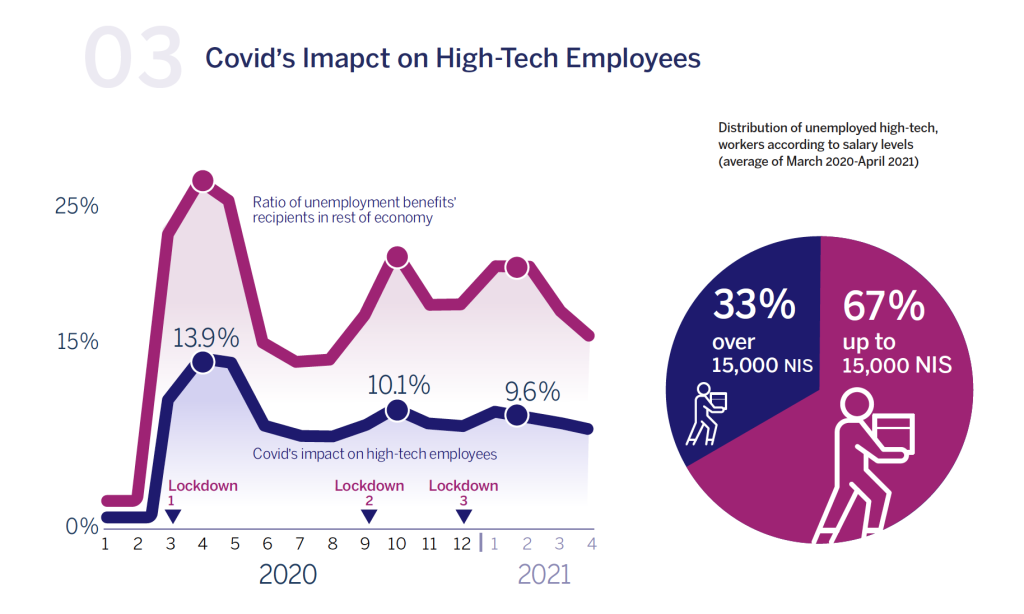
Source: Innovation Authority adaptation of NII data3The unemployment rate is calculated as a percentage of all salaried employees, in high-tech and other sectors as of the end of 2020.
The graph above presents a segmentation of high-tech unemployment benefits recipients by salary levels and shows that those earning lower than average high-tech salaries (less than NIS 15,000 a month) comprised the majority of those losing their jobs. It can be deduced therefore that most of those affected in high-tech were young employees (“juniors”) or auxiliary employees who generally earn less than the average high-tech salary which stood at NIS 25,300 a month in 2020. It seems that senior employees in technology professions were relatively less impacted during this period relative to the severity of the economic crisis. Furthermore, an Authority study revealed that the ratio of unemployment benefits recipients at high-tech companies in industrial sectors is lower than their share of the total high-tech industry.
Over the past year, the average salary in the general economy rose by 7% due to the high unemployment rates of employees earning low salaries. The average high-tech salary increased by 6% in 2020, from a monthly average of NIS 24,000 in 2019 to NIS 25,300 in 2020.4Innovation Authority adaptation of CBS data, Salary and Employment Journal – December 2020, “Salaried Jobs and Average Monthly Salary According to Primary Economic Sector, Yearly Averages”. It is reasonable to assume that part of this increase can also be attributed to the high rate of job losses of those earning lower than average high-tech salaries.
The picture emerging from a survey of the long-term trends which were intensified by the Covid crisis, highlights the importance of supporting the creation of complete high-tech companies. These companies enable additional employees, not necessarily possessing academic technology training suited to core high-tech positions, to join the industry, thereby increasing both the economy’s general level of productivity and its tax revenues, as will be presented below.
The Israeli High-Tech Professionals: Still based in Tel Aviv, Not So Young
Israeli high-tech continues to maintain its standing as a relatively closed and homogenous circle, based largely on non-Haredi (ultra-Orthodox) Jewish men. CBS data reveals that 98% of high-tech employees in Israel are Jewish (1.9% are Arabs), of which 3.4% are ultra-Orthodox.5Innovation Authority adaptation of CBS data, “High-Tech Employees, Excluding the Communications Sector, Ultra- Orthodox and Arabs, 2001-2020. Furthermore, this industry is characterized by an especially high ratio of male employees – two thirds of all those working in this field.6Innovation Authority adaptation of CBS data, “Salaried Employees in High-Tech According to Occupation (1994 Classification) and Sex, 1995-2012 and “Salaried Employees in High-Tech, Excluding the Communications Sector, According to Occupation (2011 Classification) and Sex, 2012-2018.
When examined geographically, most high-tech employees are concentrated in central Israel. Figures of the Ministry of Welfare’s Labor Branch7High-Tech Employment Survey, Roi Levanon, Ministry of Labor, Welfare, and Social Services. reveal that 61% of the high-tech industry’s employees live in central Israel, even though the overall population of salaried employees in the Tel Aviv metropolitan area comprise only 45% of the country’s workforce.8Innovation Authority adaptation of CBS data, Statistical Journal 71, The Labor Market, “Employees, According to Economic Sector, District, and Residential Area”. In contrast, 11% of high-tech employees live in northern Israel where the total share of salaried Northern employees from all sectors stands at 15%. Only 6% of high-tech employees live in Jerusalem even though the relative share of Jerusalem employees out of the total workforce stands at 9%.
In contrast to the common perception of high-tech as a young industry in which employees are expelled from the workforce at age 45, during the last 20 years there has been a steady rise in the average age. This process is also reflected in the age of high-tech employees. Today, the industry is characterized by an average employee age that is slightly higher than the overall labor market’s average employee age. As of 2019, the average employee age in high-tech stood at 40.1 while the economy’s overall average age was 39.6. At the beginning of the millennium, when large numbers of young people joined the industry, there was a sharp decline in the average age in high-tech, from 37.5 in 1999 to 36 in the year 2000. Nevertheless, as mentioned above, this figure has risen steadily over the last two decades. The estimated average entry age of new employees into high-tech varied between 27 and 31.9Innovation Authority adaptation of CBS data. The average age is calculated as a weighted average adapted to the distribution of the population’s ages in 2015. The calculation of the estimated entry age is based on two possible scenarios – one according to which 2% of the existing high-tech personnel retire or lose their jobs each year, and the second according to which this figure stands at 5%.
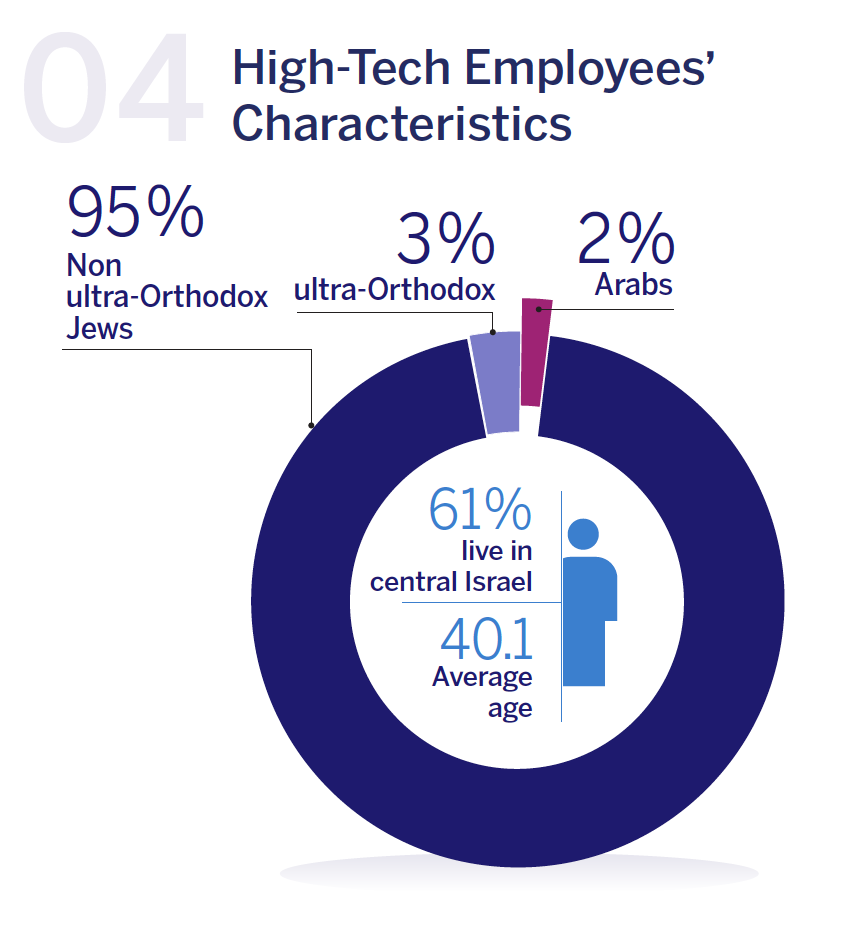
Gender differences are also prominent in the different average ages in high-tech: As of 2019, the average age of men employed in high-tech stood at 41.1 while the average age of women in the industry during this year was 37.7.10Innovation Authority adaptation of CBS data, Salaried Employees in High-Tech According to Age and Sex, 1995- 2019. The average age of male employees throughout all sectors of the economy is also higher than that of women. This difference would seem to stem from the different retirement age of men and women. However, the difference in average age over all sectors of the economy which stands at 1.78 is lower than that in high-tech where it stands at 3.4 years.11Innovation Authority adaptation of CBS data, Statistical Journal 71, The Labor Market, “People Aged at Least 15 and the Workforce, According to Years of Education, Age, Sex, and Religion.
High-Tech Employees are Responsible for One Quarter of Israel’s Tax Revenues
One of the prominent trends in Israeli high-tech during recent years is the moderation in the rate at which multinational corporations are opening new development centers in Israel. While 46 new international development centers were opened in Israel in 2015, only 23 such centers were opened in 2019 and only 4 in 2020. This trend reflects the decline in the number of Israeli startups’ M&A (mergers and acquisitions) deals and the increase in the number of initial offerings (IPOs) of Israeli companies on the stock exchange, as detailed in the previous chapter. This is because most of the multinational development centers in Israel were set up following the acquisition of a local startup company by an international corporation.
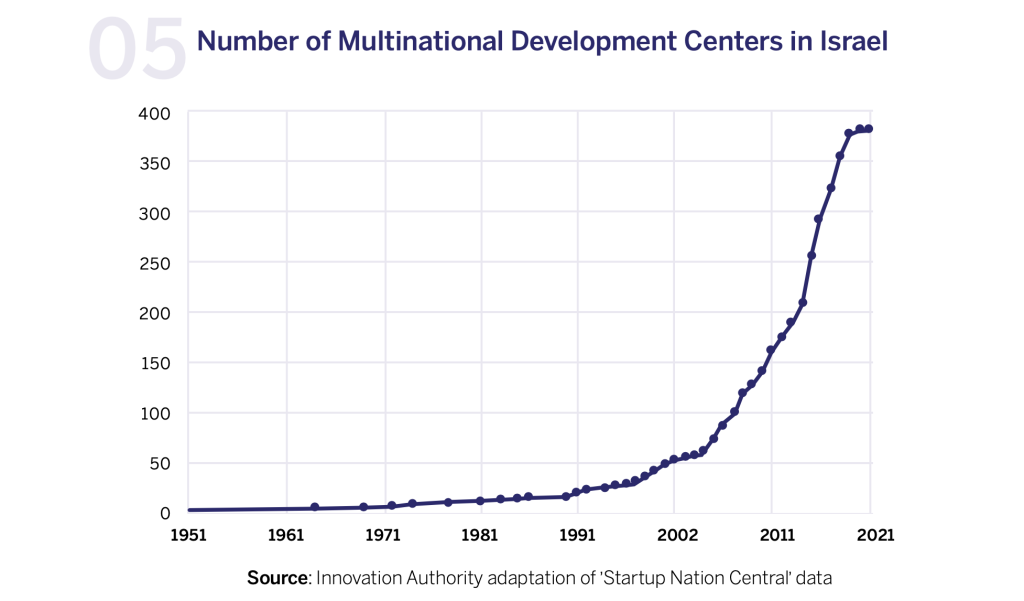
As can be seen in the graph above, the sharp increase in the number of international development centers operating in Israel over the last decade was relatively consistent with the growth in the number of high-tech workers in recent years. As a result, the percentage of employees in the development centers out of the total number of people employed in high-tech has remained stable since 2013 at a level of 20%. As of 2018, there were 57,000 employees working at the international development centers, of which 36,000 worked in technology professions.12Innovation Authority adaptation of CBS data, from “R&D in Startup companies and Multinational Corporations’ Development Centers, 2018”, R&D expenses and R&D positions in R&D Centers. In light of the downturn in the rate of new development centers in Israel, that is part of the maturation of the Israeli high-tech industry described in Chapter 1 of the report, it is possible that the proportion of employees at Israeli-owned companies out of the total number of those employed in the industry will gradually increase in coming years.
At the same time, according to the High-Tech Human Capital Report issued by SNC and the Innovation Authority, the multinational development centers operating in Israel demonstrated greater stability during the Covid crisis compared to local companies, thereby constituting a mainstay of employment relative to local companies during that period. The report also reveals that the multinational development centers utilized the crisis to enhance their workforce by replacing employees with less technology experience (up to 2 years) with other, more experienced employees. As a mirror image of the multinational corporations, local startups, in light of the harsh ramifications of the Covid crisis, were forced to dismiss even experienced technology employees.
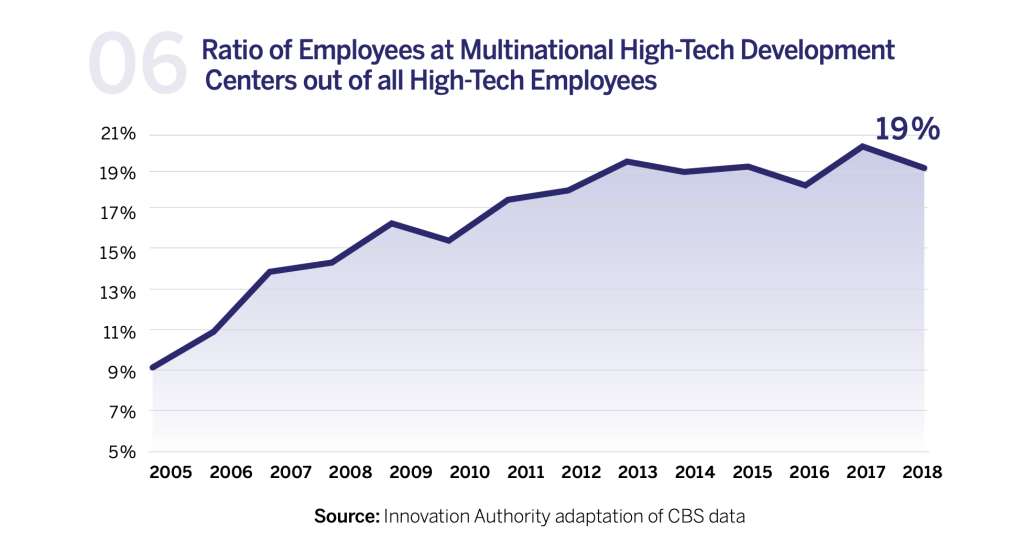
The more moderate rate at which multinational develop centers are being opened in Israel raises the question as to whether, considering salary expenses and changes in the exit model in Israel and in global corporations’ acquisitions models, the R&D centers have reached the limit of their growth in Israel. Therefore, is there a need to re-examine the policy of state incentives and taxation for R&D centers?
The answer depends on two central factors: the level of state revenue from taxation and the contribution to the growth of the Israeli ecosystem.
In general, the high-tech industry is extremely important to state revenue. The average salary in high-tech is more than double the economy’s overall average salary. An analysis of the National Economic Council reveals that in 2018, the average monthly salary in a foreign-owned company was 50% higher than that in a local company and stood at NIS 32,500 a month compared to NIS 21,700. It should be noted that part of this gap stems from the internal makeup of the companies’ employees which, in a foreign-owned company, tends more towards research and development jobs characterized by higher salaries.13According to National Economic Council adaptations of CBS data.,14A study conducted by the Chief Economist Division in the Ministry of Finance based on 2005-2010 data found that international companies pay a monthly salary that is 8.4% higher than that earned by an employee with similar characteristics at a locally owned company. OECD et al. (2018), “The Contribution of Multinational Enterprises to Labor Productivity: The Case of Israel”, OECD Productivity Working Papers, No. 11, OECD Publishing, Paris.
Accordingly, high-tech employees account for a high proportion of the total income tax collected in Israel, relative to their share of the labor market. In 2018, high-tech employees comprised 8.65% of all employees in Israel but accounted for 24% of the total income tax paid. In other words, high-tech employees are responsible for income tax payments approximately three times higher than their relative size of the workforce. Furthermore, high-tech employees at multinational corporations comprised 1.47% of Israel’s total number of employees while paying 8.3% of all income tax payments i.e., almost 6 times their share of the population, and 1.8 times their relative proportion of all high-tech employees.
Although corporate tax paid by high-tech companies constitutes a significant part of national revenue, its ratio is lower than the income tax paid by high-tech employees and is estimated at a rate similar to the industry’s share of GDP, i.e., approximately 15%.15Innovation Authority adaptation of Ministry of Finance and National Economic Council data.
International corporations have a mixed influence on the local ecosystem. On the one hand, as mentioned in the previous chapter, the development centers’ importance is rooted in the fact that they enable employment at the forefront of global knowledge and technology and expose Israeli employees to advanced international management methodologies. On the other hand, the multinational development centers employ large numbers of employees with high technological skills while the Israeli high-tech labor market suffers from a chronic shortage of such employees. The Israeli high-tech industry is maturing and has a growing number of locally owned companies. If the downturn in the opening of new development centers continues, local companies may find themselves in a position to benefit, with proficient and skilled technology employees being able to integrate into Israeli companies, thereby contributing to their growth and transformation into complete local companies. This, in turn, will widen the circle of high-productivity employment, including auxiliary workers not employed in core technology roles, who will then also pay higher rates of income tax.
Covid Has Made the High-Tech Industry Less Friendly for Women and Inexperienced Employees
One of the central and most-discussed obstacles to the expansion of the Israeli high-tech industry over the past decade is the constant shortage of experienced technology employees. The State Comptroller’s Report from March 2021 termed the high demand for technology employees “a chronic shortage of skilled employees in the Israeli high-tech industry” and defined it as “a strategic threat to the technology sector in particular, and to the Israeli economy in general”.16Annual Report 71b, State Comptroller, “National Action to Increase the Number of Workers in the High-Tech Industry”, March 2021.
The Israeli high-tech industry is contending with additional challenges in the field of human capital. These challenges, which intensified during this last year against the background of the Covid crisis, are related to the limited circle that comprises Israeli high-tech, primarily consisting of non-Haredi Jewish men and in which women and minorities are under-represented. Furthermore, the difficulty in recruiting and employing young employees without practical experience (juniors) has intensified over the last year. Nevertheless, it is too early to evaluate the extent of the damage that can be attributed to the Covid crisis. A further issue that may influence the demand for Israeli employees in the near future, on the part of both multinational and local corporations, is the strengthening of the NIS/USD exchange rate that is raising corporate expenditure due to increased salary expenses of Israeli employees.
The demand for technology workers has remained high this last year, despite the Covid crisis: as of January 2021, there were 9,106 vacant job positions for employees in high-tech professions, compared to 9,368 in January 2020.17Innovation Authority adaptation of CBS data, “Number of Vacant Jobs, November 2019-January 2020”.,18Innovation Authority adaptation of CBS data, “Number of Vacant Jobs, November 2020-January 2021”. By comparison, the overall job market registered a total of 60,500 vacant jobs in January 2021, compared to 99,000 in January 2020. According to the Human Capital Report of the SNC and the Innovation Authority, although the Covid year led to a certain decline in in the demand for technology employees, a severe shortage remained. For example, while demand for technology employees was estimated to stand at 18,500 in 2019, by December 2020 this figure was estimated to be approximately 13,000.19Human Capital in the High-Tech Industry Report 2020. The shortage in employees persisted because most high-tech employees who lost their jobs were from low pay brackets i.e., inexperienced or from non-technology professions, while the high demand that exists is for experienced employees in technology professions. It is possible that Covid restrictions intensified this trend, including the transition to working from home, which made it significantly more difficult for companies to recruit and mobilize new and inexperienced employees.
As mentioned, it is still early to evaluate the Covid year’s long-term impacts on women and on gender equality in the labor market at large, and specifically, on women employed in high-tech. Although a study conducted by the Chief Economist Division at the Ministry of Finance revealed no widening of the average employment disparities between men and women during the Covid period, such disparities were registered during lockdown periods.20See Gender Gaps in the Labor Market and the Covid Crisis Report, April 2021. For example, 94,000 new job seekers registered during the second lockdown imposed in September 2020 due to second or more periods of unpaid leave, 63% of whom were women.21The Gender Index – Gender Inequality in Israel 2020, A Special Spotlight – Gender Ramifications of the Covid Pandemic, Van Leer Institute. One of the main reasons for this is the lack of children’s educational frameworks that exacerbated gender role disparities and the performance of transparent childcare-related work by women.22The Gender Index – Gender Inequality in Israel 2020, A Special Spotlight – Gender Ramifications of the Covid Pandemic, Van Leer Institute.Adverse employment ramifications for women are not an exclusively local phenomenon. In September 2020, a survey published by ‘Lean In’ and McKinsey revealed that 2 million women in the US are considering taking unpaid leave or leaving their job entirely as a result of Covid.23Lean In and McKinsey “Women in the Workplace 2020” Report.The strongest influence was seen among women with children aged under 10 years. 23% of these women reported that they are considering leaving the labor market because of Covid. The long-term ramifications are severe because this reality will result in less women advancing to management positions and to wider gender disparities in the labor market.
Although there has not been a significant drop in the number of female high-tech employees during this last year, women’s under-representation in Israeli high-tech, already a significant challenge prior to the Covid crisis, persisted throughout 2020. Israeli high-tech is characterized by a large male majority, especially in the technology professions. As of 2020, women comprised just 34% of those employed in Israeli high-tech, a rate that has remained almost unchanged for two decades. As evidence, while the number of men employed in high-tech increased by 10,000 over the past year, the number of women working in the industry rose by only 3,000.24Innovation Authority adaptation of CBS data “Salaried Employees in High-Tech According to Economic Sector (2011 Classification) and Sex”.
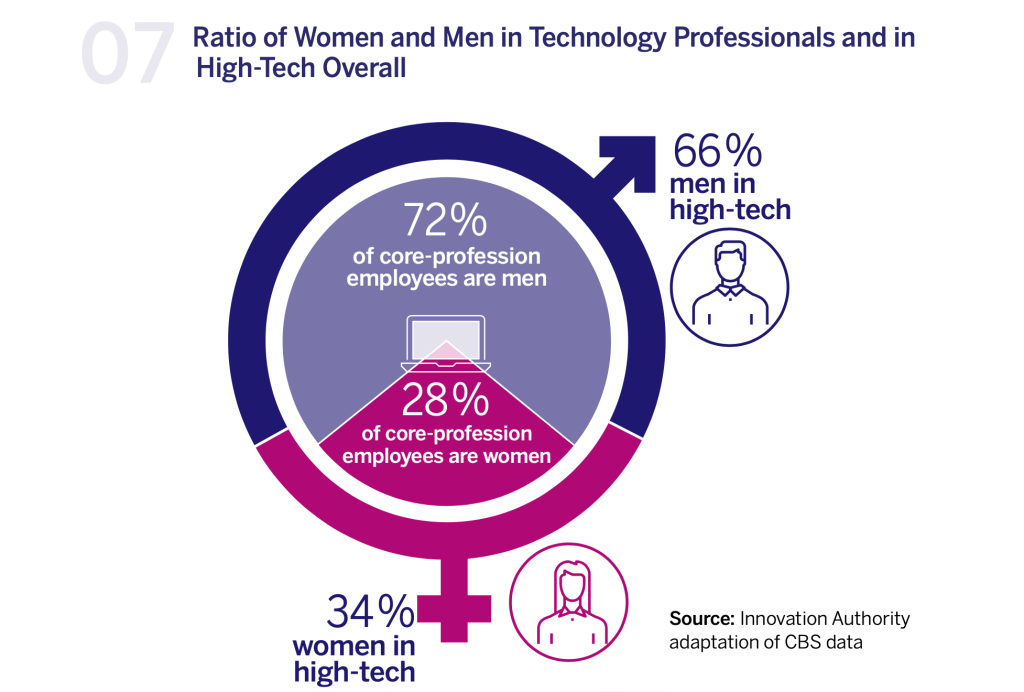
As of 2019, women constituted only 28% of all technology professionals in high-tech, even lower than their share in the industry.25Innovation Authority adaptation of CBS data “Salaried Employees in High-Tech According to Economic Sector (2011 Classification) and Sex”. Furthermore, during this year, less than half the women employed in high-tech worked in technology professions, compared to 65.6% of the men.26Innovation Authority adaptation of CBS data, “Salaried Employees in High-Tech According to Occupation (1994 Classification) and Sex, 1995-2012 and “Salaried Employees in High-Tech, Excluding the Communications Sector, According to Occupation (2011 Classification) and Sex, 2012-2018. Although the number of women in high-tech technology professions has been steadily increasing since 2013, significant gender gaps remain. Moreover, large gender gaps also exist in the field of entrepreneurship. According to SNC, only one of every 10 entrepreneurs establishing a startup company in 2020 was a woman – a ratio that has remained almost without change over recent years.27“Human Capital in the High-Tech Industry 2020” Report. A similar ratio can be seen in the number of female CEOs of high-tech companies in Israel.28IVC Report published for International Women’s Day 2021.
One in Every Four Students in Israel Studies a Technology Profession. What Will the Industry’s Future Look Like?
An examination of the future high-tech professionals, influenced by the number of students in high-tech study courses, shows that there has been a significant increase in the number of students acquiring higher education in technology subjects in recent years. In the current 2020-21 academic year, 18.4% of all bachelor’s degree students are studying engineering subjects – the most popular study course in Israel. Furthermore, the number of students studying mathematics, statistics, and computer science has doubled over the last decade, from 9,122 in 2020 to 18,243 in the current academic year. In other words, as of 2020, one in every four students in Israel is studying for a bachelor’s degree in a technology study field such as engineering or computer science. Moreover, one of every three students in Israel today is studying for a bachelor’s degree in a science (STEM) subject,29STEM subjects are science, technology, engineering, and mathematics. an increase of 22% since 1995.30Innovation Authority adaptation of PBC data, “Opening of the 2020-21 Academic Year with Covid”.
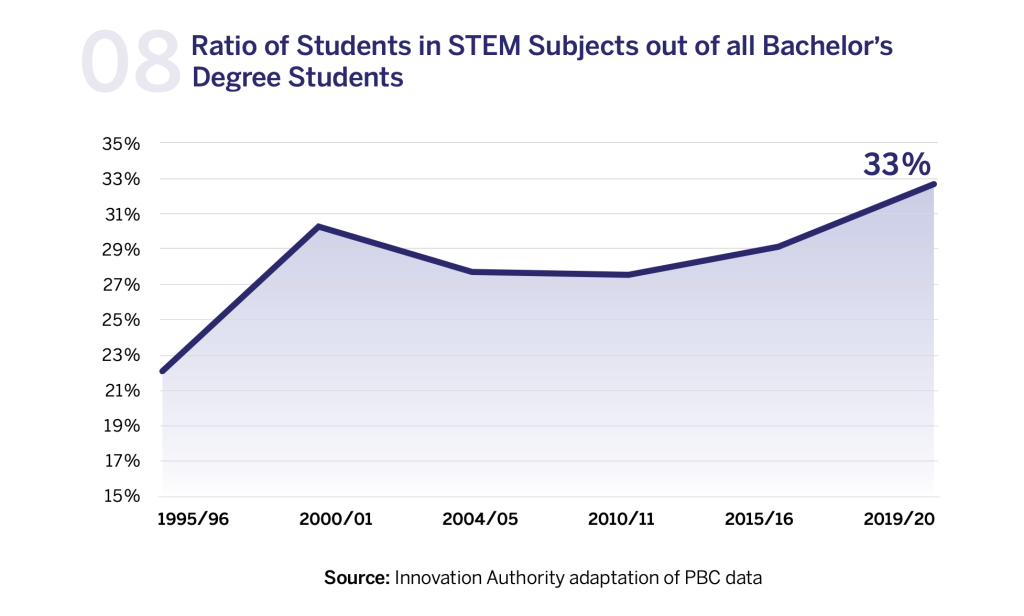
At the same time, the number of female students studying for a bachelor’s degree in computer science, including mathematics and statistics, has more than doubled from 2,622 in 2010 to 6,144 in 2019. A significant increase was also registered in the number of women deciding to study engineering, from 8,581 in 2010 to 12,241 in 2020. In total, the number of women studying for a bachelor’s degree in science subjects in 2020 stands at approximately 23,000. Nonetheless, as of 2020, the ratio of women out of all students studying for science degrees stands at 36%, and only 33% in computer science and engineering.31Innovation Authority adaptation of Planning and Budgeting Committee (PBC) data, “Students in the Higher Education System, According to Degree, Type of Institution, and Sex, 2019-20 Academic Year. In other words, the increase in the number of female students in science subjects is consistent with the general rise in the number of students in these subjects. It is possible that this is the reason that the ratio of women in technology jobs in the high-tech industry is expected to remain constant at approximately one third in the years to come.
Despite the constant and significant increase in the number of students in technology subjects in recent years, the State Comptroller’s report published in March 2021 warns of two central long-term obstacles to increasing the number of university graduates in high-tech subjects:
1. Shortage of senior academic personnel in faculties of high-tech subjects in general and particularly, computer science.
2. High dropout rate of students in these subjects.32Annual Report 71b, State Comptroller, “National Action to Increase the Number of Workers in the High-Tech Industry”, March 2021.
According to the report, 22% of the students who began their studies for a university degree in computer science, failed to complete their studies within six years. Furthermore, 20% of the students who began studies in this subject eventually graduated with a degree in another subject.33Innovation Authority adaptation of CBS data, “Students at The Open University, According to Degree, Study Year, Subject, Sex, Age, Population Group, and Area of Residence”. It is possible therefore that some of the students who met the stringent criteria for studying high-tech subjects at university will fail to integrate into the high-tech industry, or at least into a job that requires a relevant academic degree. The significance of this is that the potential human capital suited for the high-tech industry is not fully utilized, as also mentioned by the Chief Economist in the Ministry of Finance.34See publication from January 2021, “Who becomes a startup professional?”
Considering the ongoing increase in the number of students studying science subjects, tens of thousands of young workers with academic technology training but with only limited (if any) experience, are expected to join the high-tech industry each year. If a third of the students in Israel continue to turn to science subjects, more than 20,000 employees with limited experience will join the high-tech industry in 2030, compared to approximately 15,000 today. Moreover, if the ratio of students in academic high-tech subjects reaches 40% in 2030, in accordance with the target designated by the government,35National Program for Increasing Skilled Human Capital in the High-Tech Industry, Government Resolution No. 2292, 2017. more than 25,000 new employees will join the industry in that year. As a result, the supply of young technology employees in high-tech is expected to grow significantly in the years to come and may alter the industry’s patterns of employing and employment, such as a decline in initiated transitions between jobs and even a potential drop in salaries.
In 2030, between 20-30 thousand high-tech graduates are projected to join the workforce, and the problem of juniors is expected to intensify.

Source: Innovation Authority adaptation of CBS and PBC data36The calculation models two scenarios whereby the ratio of students in these subjects will stand in 2030 at the current level of 33%, and at 40% via a process of gradual change.
The significant increase expected in the number of young employees without vocational experience who will soon join the labor market will intensify the problem of the juniors who today constitute only 11% of employees in the industry.37Human Capital in the High-Tech Industry Report 2020. There is therefore a significant and urgent need to find a solution for the difficulties involved in recruiting the young employees in the hightech industry. Alongside the problem of the juniors is the strength of the shekel that leads to an increase in the expenses associated with all high-tech employees, but which make the Israeli juniors especially expensive compared to markets to which companies transfer development jobs via outsourcing. Over time, the market may “adjust itself” and lower employees’ salaries, leading to better congruency between companies’ demand for inexperienced employees and the number of new graduates from academia in coming years.
Today, the Innovation Authority operates designated training programs for high-tech employees that include emphasis on placement in companies for employees completing the training. Furthermore, it is proposed to consider supporting specialization programs and student jobs in different high-tech companies during academic studies. In light of the great economic importance of creating well paid jobs and of improving digitization in the public sector, there is also room to consider other avenues aimed at harnessing the initial jobs offered by the public sector. These steps will have several benefits: the creation of opportunities for employees to acquire experience, improved digital service provided to the citizens, and enhanced efficiency in government departments that will hire employees with high-quality academic education.
